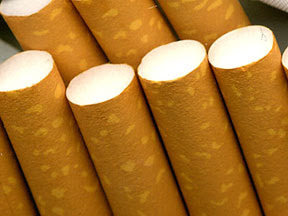
Bite-size dissolvable orbs that look like breath mints and melt in your mouth are the tobacco industry’s latest attempt to fight falling U.S. cigarette sales.
Charlotte is one of two test markets for Winston-Salem-based Reynolds American Inc.’s newest products: dissolvable, smokeless tobacco lozenges that come as orbs, sticks or strips.
The products all contain less nicotine than cigarettes, between 0.5 and 3 milligrams instead of 12 to 15. Reynolds spokesman David Howard said they meet a “societal expectation.”
“There’s no secondhand smoke, no spitting and no cigarette butt litter,” Howard said.
Health officials still worry about the risks of smokeless options. Smokeless tobacco users may not get lung cancer, health experts say, but they risk mouth cancer, gum disease and tooth loss. Prenatal dangers for pregnant women also still exist.
“There are no safe tobacco products,” said Dr. Matt Carpenter, a clinical psychologist and associate professor at the Medical University of South Carolina who’s researching the effect of smokeless products on smoking habits.
Huntersville resident Joey Hodge, who’s smoked for almost five years, sees the appeal of smokeless products that won’t be as tough on his lungs or make him smell like smoke, but the 20-year-old isn’t sold on Reynolds’ newest offering.
“They were definitely not the greatest thing I’ve ever tasted,” Hodge said. Plus, he added, the products “really didn’t do much” to satisfy his nicotine craving.
Hodge’s reaction isn’t the sort tobacco makers are hoping for. As cigarette sales slide because of the health risks and social stigma, tobacco companies are counting on smokers like Hodge to fuel the new smokeless market. The dissolvable products sell for about $2 for a 12-pack - comparable, Reynolds says, to its other smokeless products.
“They can enjoy tobacco pleasure without bothering others and without having to leave the workplace, or the restaurant or the bar,” Howard said.
Analysts say new laws banning cigarettes in public places, like the ban on smoking in restaurants and bars that took effect in North Carolina last January, are among the factors driving a steep decline in cigarette sales.
“In recent years you’ve seen smoking banned in most states in most bars and restaurants. That kind of takes away the fun,” said Phil Gorham, industry analyst for investment firm Morningstar.
In its second quarter earnings report last month, Reynolds reported the number of cigarettes sold in the U.S. fell 4.4 percent. Gorham said companies like Reynolds can combat falling sales by increasing prices in the short term, but they’ll eventually need to diversify revenues.
While American sales of cigarettes drop 3 percent to 4 percent every year, the market for smokeless products grew 3 percent in 2009 and 7 percent in 2010, said Mary Gotaas, tobacco industry analyst for researcher IBISWorld. This year, smokeless sales are expected to jump 8 percent, Gotaas said.
While Reynolds is testing its new dissolvables, Richmond, Va.-based rival Philip Morris has its own product in the works: a dissolvable tobacco stick.
The growth of smokeless products worries some public health advocates who think the new products appeal to children. During the first round of testing, the orbs’ packaging resembled Tic Tacs, creating concern that children might confuse them with candy, said Dr. John Spangler, professor of family health and community medicine at Wake Forest Baptist Medical Center.
For this round of testing, there’s larger packaging and new warnings. Packages now say “This product contains nicotine and is for adult tobacco consumers only” and “There is no safe tobacco product,” in addition to one of four required FDA warnings.
The Tobacco Products Scientific Advisory Committee of the FDA is holding hearings exploring the implications of smokeless products. Right now, all tobacco products must be age-restricted and kept behind the counter, just like cigarettes.
Warning labels on smokeless tobacco products must cover at least 30 percent of the packaging and every product must carry one of four messages: “Smokeless tobacco is addictive,” “This product can cause mouth cancer,” “This product can cause gum disease and tooth loss,” or “This product is not a safe alternative to cigarettes.”
Howard said there’s no expectation that smokeless dissolvables will be regulated less strictly than other tobacco products. Sen. Sherrod Brown, D-Ohio, one of 12 senators who called for the hearings, called dissolvables the latest way for tobacco companies to stay “one step ahead of the sheriff.”
One issue on the committee’s agenda: the potential use of smokeless tobacco products as quitting aids. Gotaas said that appeal is one of the factors driving smokeless sales.
Dean Torrance of Charlotte, a smoker for 20 years, has tried, and failed, to quit. She said smokeless products may be just what she needs.
“I would like to be able to do smokeless to get me to stop,” Torrance said.
Doctors say there are safer ways to quit smoking. Both Spangler and Carpenter recommend their patients use tested and proven medications, such as nicotine replacement pills and patches, instead of other tobacco products with unknown consequences that could keep them addicted.
Said Carpenter: “The very best thing that anybody can do for their health, if they’re a smoker, is to quit all tobacco products completely.”

Комментариев нет:
Отправить комментарий